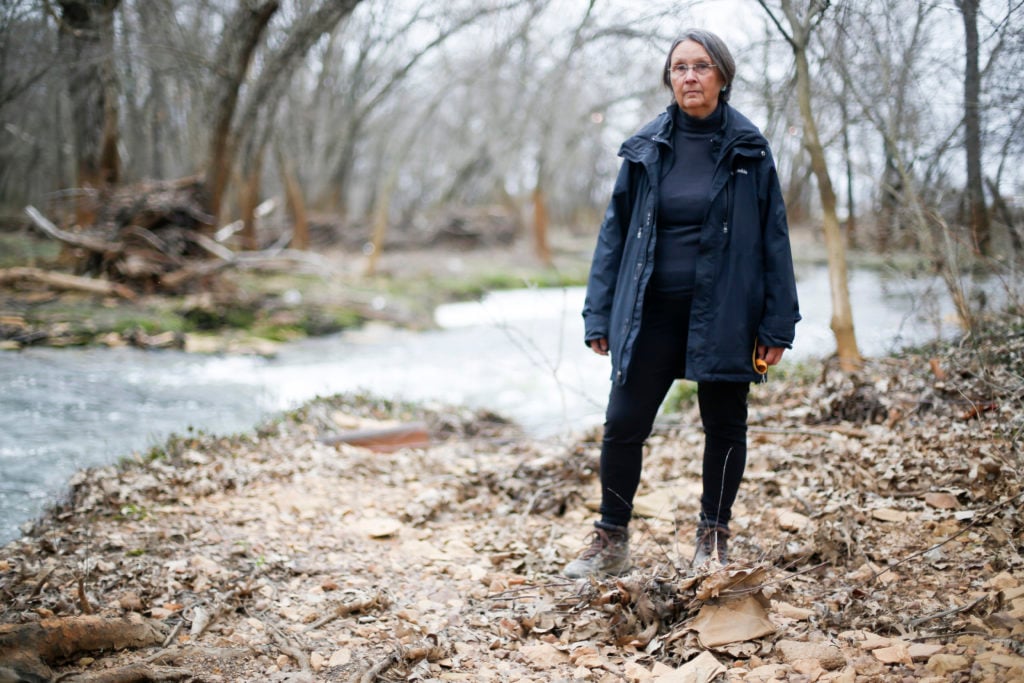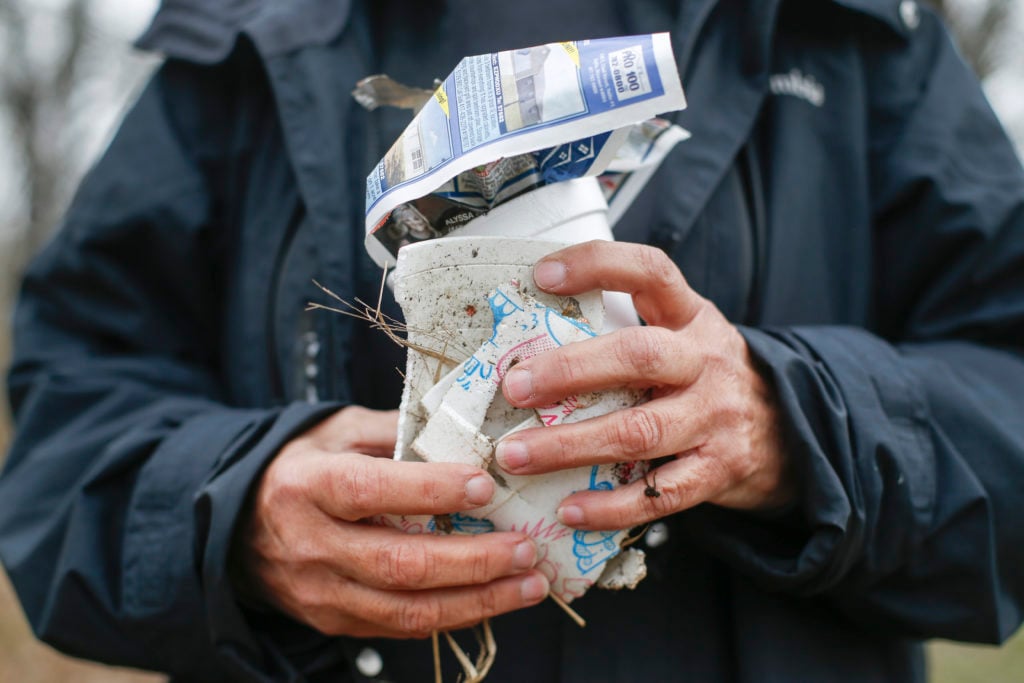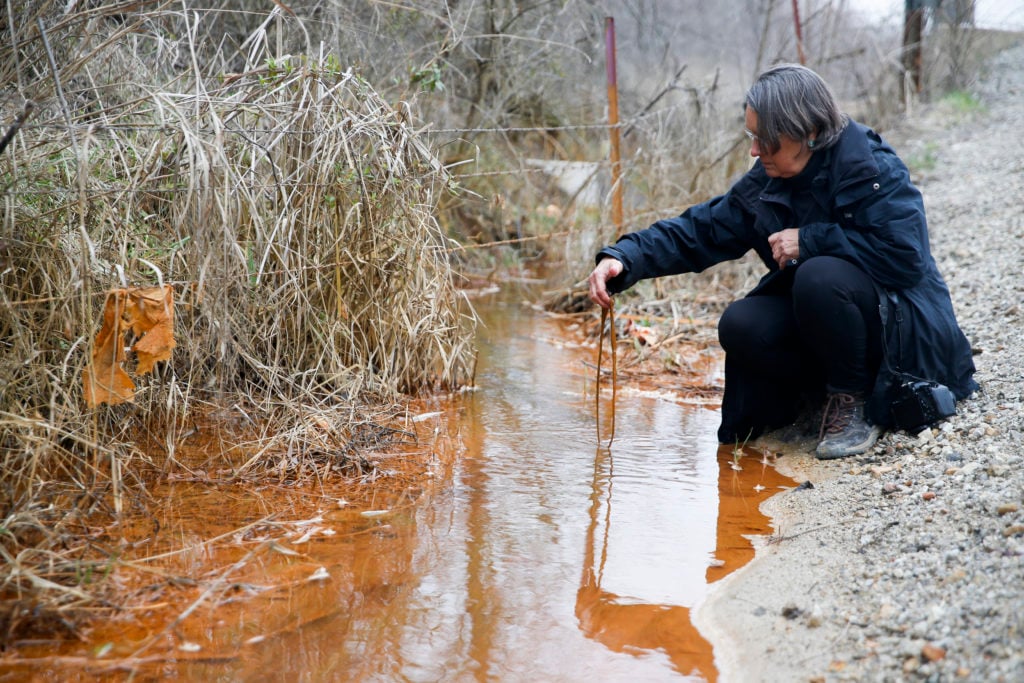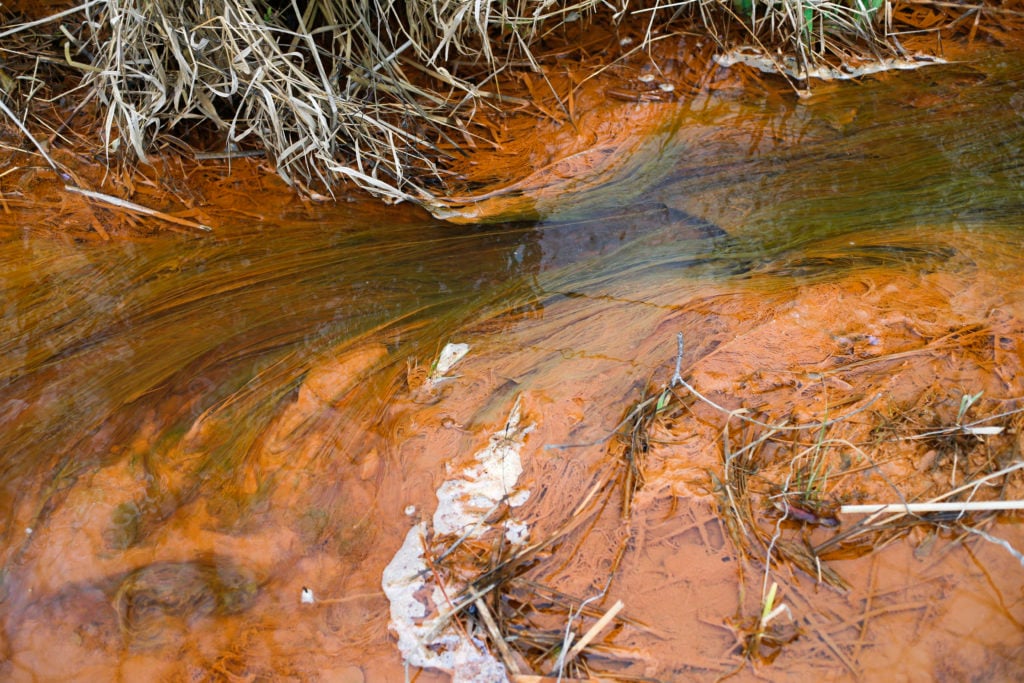The Death & Life of Tar Creek | Rebecca Jim, Tar Creekkeeper
By: ajcarapella
At one of America’s worst Superfund sites, Rebecca Jim keeps the faith.

By Robin Meadows.
Photos by ©Ian Maule, courtesy of Culture Trip.
Tar Creek springs from the ground in southeast Kansas, and then meanders through gently rolling farmland and tallgrass prairie. It’s beautiful here. On a bright January day, the creek reflects the blue of the sky, trees with black bark line the banks, and brilliant red haw berries add a joyful splash of color. A turtle suns itself in the water, a cardinal wings by, and meadowlarks perch overhead.
“I love this place,” says Tar Creekkeeper Rebecca Jim. “It’s really magical.”
The magic doesn’t last long, though. Just a mile from its headwaters, where Tar Creek reaches Oklahoma, it runs through the heart of the Tar Creek Superfund site: 40 square miles of former lead and zinc mines. Set in the northeast corner of the state, the site is within the historic boundaries of the Quapaw Nation, and is surrounded by other tribal lands, including Miami, Ottawa and Peoria. The mining began in the early 1900s, and ultimately produced one of the highest outputs of lead and zinc worldwide, supplying raw materials for bullets for the U.S. military in both world wars.
Many Quapaws were cheated out of their fair shares of the mining profits and were stuck with the devastating environmental consequences. As mine operators milled the ore to concentrate the metals, they discarded the leftover mine tailings on the land. Today the Tar Creek Superfund site is dominated by piles of tailings, called “chat,” that are up to 200 feet high and have lead levels up to 15,000 parts per million (ppm), which far exceeds the U.S. Environmental Protection Agency (EPA) standard for lead in soil.
After the ores became depleted in the late 1960s, and the mining ended, Tar Creek’s troubles began. When they were operating, the mines had been pumped dry. But when the mining stopped, so did the pumping, and groundwater seeped back in. Once in the mines, this water became acidic and laced with heavy metals, including lead, zinc, cadmium, and arsenic.
Eventually, the mines became so full of tainted water that it began to pour out of mine shafts, air-vents and exploratory boreholes, poisoning the adjacent land and Tar Creek. “One million gallons of tainted water every day since 1979,” Rebecca says. “My creek is not a very long creek – it’s 11 miles – but it’s one of the most toxic creeks in the country.”
Forty years after the contaminated water first surfaced from the mines, Tar Creek is still on the EPA’s list of the nation’s top 10 worst Superfund sites. “A lot of people are sick from the site, a lot of kids were lead-poisoned here,” Rebecca says. “A lot of human potential has been lost.”
Government agencies have made progress removing and replacing contaminated soil in people’s yards and around area schools. They also bought out residents of two towns, Picher and Cardin, where the ground was so riddled with mine tunnels that it had become unstable. But, ironically, far less has been done for the creek that gives the Superfund site its name.
Rebecca came to the Tar Creek area to pursue her career as a middle and high-school counselor. She graduated from Southern Colorado State College, now Colorado State University-Pueblo, spending her last two years on the Southern Ute Reservation in Ignacio, Colorado, through Teacher Corps, a federally funded program for low-income areas. Then she went on to earn a master’s degree in counseling from Northeastern State College, in Tahlequah, now Northeastern Oklahoma State University.

Her first counseling job was in Sapulpa, Oklahoma, and Rebecca moved to the Tar Creek area in 1978, when she was in her late 20s, to work in the local school system. “I came the year before the creek turned bad,” recalls Rebecca, who is Cherokee and was hired with federal funding to be the Indian Counselor for the region’s many Native American students, a job she held for 25 years. “One of my students had been fishing the day before it happened. The next day all the fish were dead. It was a shock to see it ruined.”
And Tar Creek was an electric orange. The color comes from iron. When acid mine water surfaces and is exposed to oxygen in the air, that essentially rusts the iron in the water. The water stains everything it touches, from rocks in the streambed to tree trunks to bridge supports. They’re all orange. You didn’t need to test the water to know something was very wrong.
“Tar Creek looks like an orange ribbon from the air,” Rebecca says.
Rebecca initially became an advocate for her creek for the sake of her students. “In the early 1990s, I sponsored the Indian Club, which started doing service-learning projects,” she says. “I got the kids involved and they took on Tar Creek.” Cleanups were out of the question: anything her students touched would poison them.
But they could and did raise awareness with events like “Toxic Tours” of the creek, conducted by bicycle, as well as mock fishing tournaments, which highlighted the fact that people could no longer fish in Tar Creek. In recognition of these exceptional educational initiatives, the Corporation for National and Community Service honored Rebecca with its Learn and Serve Spirit of Service award.
In the meantime, Rebecca invited Earl Hatley to visit so her students could learn more about Tar Creek’s woes. Also of Cherokee ancestry, Earl was a community organizer who had worked at all of Oklahoma’s other Superfund sites. She had met him at environmental events; they became sweethearts, and he moved to the Tar Creek area in 1997 to be with her. They ultimately decided to try to raise awareness about the creek, focusing on adults, at community meetings. “The kids were doing their share, but adults could do more,” Rebecca says.
“Rebecca really cares so deeply about the community, the environment, and our tribes, she still gets a gleam in her eye when she thinks there’s more she can do to help – she’s shaped many lives.”
One of these things was to attend meetings with officials from government agencies charged with cleaning up the Tar Creek Superfund site. At a 1997 meeting, George Mayer took the assembled officials to task. Mayer owned the land where the toxic mine water had first emerged nearly 20 years earlier and was still pouring out. “George said, ‘You promised to plug the boreholes in 1979 – who is the lead agency on this?’” Earl, who became Grand Riverkeeper in 2003, recalls, adding that Mayer got no answer. The next day, Rebecca knocked on Mayer’s door. “I told him, ‘We’ll be the lead agency,’” she says.
Rebecca made good on her promise. In 1997 she and Earl co-founded a nonprofit group dedicated to environmental issues in northeast Oklahoma. Fittingly, they called it the LEAD Agency and decided the acronym stood for “Local Environmental Action Demanded.” “We’re the ones leading the way for environmental justice,” Rebecca says. “Tar Creek is very expensive to clean up, and this is a small, poor community with very little political clout.”
LEAD Agency initiatives have included ramping up the Toxic Tours, which are now taken by bus; Rebecca’s weekly newspaper column to keep local people in the loop on Tar Creek; and establishing the Tar Creek Environmental Conference. Free to residents of Ottawa County, the location of the Tar Creek Superfund site, the conference includes presentations from agency and tribal program managers working at the site as well as researchers and health experts. “It’s all about keeping attention on Tar Creek,” Rebecca says.
The conferences also led to Rebecca becoming, after many years of advocacy, the official Tar Creekkeeper in 2016. Waterkeeper Alliance Executive Director Marc Yaggi had been the keynote speaker, and encouraged her to apply.
“I felt that being part of Waterkeeper Alliance would give us an even stronger voice,” she says.
The Alliance recognized Rebecca and Earl individually for their outstanding work at its annual conference in 2018. Each of them was honored as a first recipient of the Terry Backer award, named for legendary Long Island Soundkeeper Terry Backer, who was one of the founders of the Waterkeeper movement.

Last year marked the 20th Annual Tar Creek Environmental Conference, and speakers included Scott Thompson, executive director of the Oklahoma Department of Environmental Quality; Jim Reese, Oklahoma Secretary of Agriculture, Food and Forestry; Charles Lee, senior policy advisor for Environmental Justice at the EPA; and Daniel E. Estrin, Waterkeeper Alliance’s general counsel and advocacy director.
Rebecca gives her all to being Tar Creekkeeper. Earl describes her as a “hummingbird” who “has two speeds – superfast and stop. Stop is when she lays her head down to sleep, otherwise she’s go-go-go. You can’t keep up with her.”
A combination of dedication, optimism, and kindliness helps Rebecca keep people focused on the needs of her creek. “There’s a warmth to her,” Earl says. “She’s the happiest person I know.”
Earl credits Rebecca with helping the community fully understand the impact of the mines’ toxic legacy. When he and Rebecca founded the LEAD Agency, “local people did not understand that Tar Creek was a problem,” Earl says.
The Superfund site where tainted water pours into the creek is in a rural area north of the region’s towns, where people generally have little reason to go. And most of the creek is flanked by thick riparian vegetation, which conceals the damage.
In fact, the impact of heavy metals in the water goes far beyond the creek. “What goes down my creek hits other tribal regions,” Rebecca says. Tar Creek flows into the Neosho River, which in turn flows into the Grand River. The latter was dammed to create a lake for drinking water. “The lake carries the burden of Tar Creek,” Earl, says. “The sediment has toxic metals.”


Now, people in Ottawa County recognize that Tar Creek is still in deep trouble. “Rebecca has brought a lot of awareness to Tar Creek – it’s a huge turnaround,” Earl says. “They understand that it’s a problem and they want it fixed.”
Karen Fields, a Miami tribal member who played in Tar Creek as a child before the water went bad, is one of those people. “I think the local concern all started with Rebecca,” Fields says. “Nobody knew it was a hazard.” Fields met Rebecca in the late 1970s, when Rebecca was her children’s counselor, and decades later Fields worked as a research assistant on a Harvard-led study of heavy-metal exposure in local children.
“Rebecca really cares so deeply about the community, the environment, and our tribes,” she says. “She still gets a gleam in her eye when she thinks there’s more she can do to help – she’s shaped many lives.”
Government officials have designated Tar Creek as “irreversibly damaged” but Rebecca doesn’t believe that. Neither does Robert Nairn, a University of Oklahoma professor who specializes in environmental engineering. Over the last decade, Nairn has run a pilot project to see if he could treat the toxic mine water on George Mayer’s ranch. The treatment involves a series of ponds that use natural processes to rid the polluted water of heavy metals. The water starts out orange in the first pond, and ends up blue in the last one. “After treatment,” says Nairn, “the water meets stream water-quality standards.”
Rebecca was key to getting his project off the ground. “Local support is critical and she facilitates meeting local landowners,” Nairn says. “Then we can sit down with each other, have coffee, and talk about what we’re trying to do.”
“We want swimmable, fishable, drinkable water. I’m still working for the day when we can say, ‘yes, meet me at the creek.’”
Mayer Ranch is only one of several places where contaminants pour into Tar Creek. Nicholas Shepherd, who is a PhD student with Nairn, is working to extend Nairn’s technique to the part of the Superfund site where toxic mine water pours out most profusely. Shepherd, who grew up in the area and is also of Cherokee ancestry, began devising ways to clean up the creek as a student. Rebecca invited him to speak at a Tar Creek conference when he was in high school, and Nairn was in the audience. “Rebecca brings people together,” Shepherd says.
Shepherd is optimistic that his project will work but, he adds, toxic mine water is not the only source of heavy metals in Tar Creek. The discarded mine tailings, or chat, are also a major source. “Contaminated water pours out from chat piles – it will pour out for weeks after a rain,” Rebecca says. An estimated 40 million tons of chat looms over the Tar Creek Superfund Site.
“What they need to do is put a waste-water-treatment plant here,” Rebecca says. “We keep reminding the EPA that we want it to be better.”
In March 2019, the EPA released a five-year plan for the Tar Creek Superfund site “to improve cleanup progress.” The agency also committed more than $16 million a year for the duration of the plan toward the cleanup effort.
Rebecca envisions a future where local people enjoy Tar Creek the way they did when she first arrived. “We want swimmable, fishable, drinkable water,” she says. “I’m still working for the day when we can say, ‘Yes, meet me at the creek.’”
Robin Meadows is a science journalist in the San Francisco Bay Area. She is the water reporter for the Bay Area Monitor, and her work has also appeared in Audubon, Conservation, High Country News, Water Deeply and others.